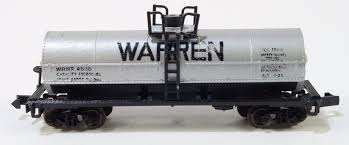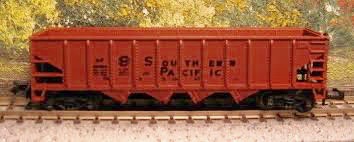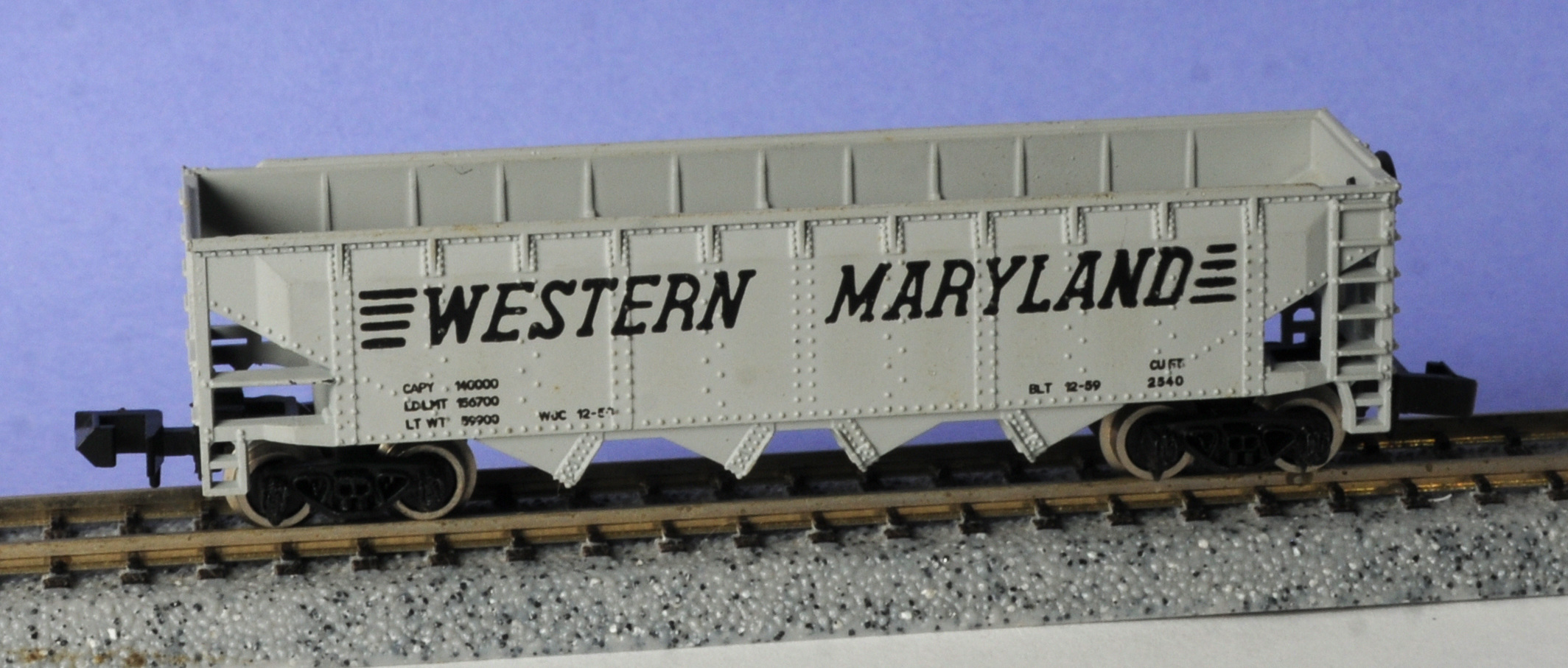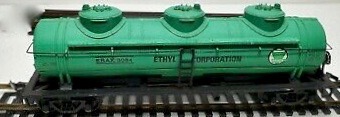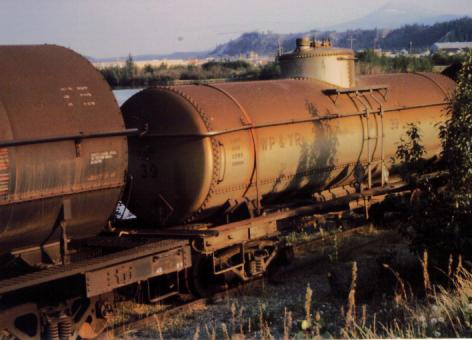Prototype History: Single Dome tank cars are a railroad staple. They have been around since the first half of the 20th century. This length car can handle about 10,000 gallons. These railcars carry a wide array of commodities, including liquid fertilizers, chemicals, fuel oils and asphalt, and food-grade oils. Tank cars can be pressurized or non-pressurized, insulated or non-insulated. Single dome cars carry only a single commodity at once. Food-service tank cars may be lined with stainless steel, glass, or plastic. Tank cars carrying dangerous goods are generally made of different types of steel, depending on the intended cargo and operating pressure. They may also be lined with rubber or coated with specialized coatings for tank protection or product purity purpose. The tank heads are also stronger to prevent ruptures during accidents.
One common version is the ACF Type 27 jacketed tank car with expansion dome which was in common use by many railroads and oil companies.
One common version is the ACF Type 27 jacketed tank car with expansion dome which was in common use by many railroads and oil companies.
Road Name History: 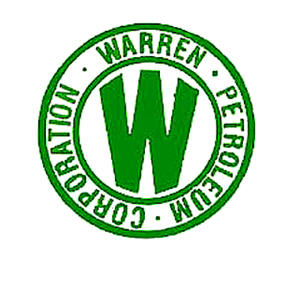 The Tulsa-based Warren Petroleum Company was founded by William Kelly Warren (1897–1990). Born in Nashville, Tennessee, on December 3, 1897, Warren was the son of Thomas Hines and Amelia Elizabeth Cecil Warren. While attending parochial schools in Nashville, he became acquainted with Myrtle (Mrs. Daniel A.) McDougal of Sapulpa, Oklahoma, who advised him to "go West." Heeding her advice, in February 1916 he boarded the train to Sapulpa, and he was awed by the booming oil industry. Before leaving Nashville, Warren met Natalie Overall, and while he was in Oklahoma their relationship grew. They were married on September 21, 1921, and had six daughters and one son.
The Tulsa-based Warren Petroleum Company was founded by William Kelly Warren (1897–1990). Born in Nashville, Tennessee, on December 3, 1897, Warren was the son of Thomas Hines and Amelia Elizabeth Cecil Warren. While attending parochial schools in Nashville, he became acquainted with Myrtle (Mrs. Daniel A.) McDougal of Sapulpa, Oklahoma, who advised him to "go West." Heeding her advice, in February 1916 he boarded the train to Sapulpa, and he was awed by the booming oil industry. Before leaving Nashville, Warren met Natalie Overall, and while he was in Oklahoma their relationship grew. They were married on September 21, 1921, and had six daughters and one son.
With McDougal's help, Warren found a job with the railroad serving Depew and Shamrock in the heart of the oil country. That job lasted five days. He could not resist the lure of the oil fields. Wanting to gain all the experience he could, he worked for Gypsy Oil Company, Gilliland Oil Company, Gulf Oil Corporation, Margay Oil Corporation, and McMan Oil and Gas Company in Oklahoma, Texas, and Louisiana during the following months. Finally, on March 15, 1922, he founded Warren Petroleum Company of Delaware, headquartered in Tulsa. He had three hundred dollars in the bank, and the company had two employees, Warren and his wife.
Wanting to find his niche in the petroleum industry, Warren concentrated on marketing natural gasoline and liquefied petroleum gases (LPG) by purchasing the production of gasoline plants. By 1925 the company owned the output of thirty-one plants in five states and by 1929 had expanded to fifty plants. In 1929 Warren organized Western Gasoline Company, which became Warren Petroleum Company of Oklahoma in 1932 and Warren Petroleum Corporation in 1937. By 1953 one of the largest producers and marketers of natural gasoline and LPG in the world, the company had more than two thousand employees, six shipping terminals in Texas, New Jersey, Florida, and Alabama, LPG plants in Oklahoma, Texas, New Mexico, Illinois, and Indiana, and the world's largest privately owned fleet of railroad tank cars. When Gulf Oil Corporation purchased Warren Petroleum Corporation for more than $420 million on November 10, 1953, it was the largest exchange of money in the nation's energy industry up to that time.
William Warren founded the Transwestern Pipeline Company in 1959. However, most of his time was occupied by the William K. Warren Foundation, which he had established in 1945 and which received the legacy of Warren Petroleum Corporation. The foundation was instrumental in the establishment of Tulsa's St. Francis Hospital in 1960. Warren died in Tulsa on June 12, 1990.

With McDougal's help, Warren found a job with the railroad serving Depew and Shamrock in the heart of the oil country. That job lasted five days. He could not resist the lure of the oil fields. Wanting to gain all the experience he could, he worked for Gypsy Oil Company, Gilliland Oil Company, Gulf Oil Corporation, Margay Oil Corporation, and McMan Oil and Gas Company in Oklahoma, Texas, and Louisiana during the following months. Finally, on March 15, 1922, he founded Warren Petroleum Company of Delaware, headquartered in Tulsa. He had three hundred dollars in the bank, and the company had two employees, Warren and his wife.
Wanting to find his niche in the petroleum industry, Warren concentrated on marketing natural gasoline and liquefied petroleum gases (LPG) by purchasing the production of gasoline plants. By 1925 the company owned the output of thirty-one plants in five states and by 1929 had expanded to fifty plants. In 1929 Warren organized Western Gasoline Company, which became Warren Petroleum Company of Oklahoma in 1932 and Warren Petroleum Corporation in 1937. By 1953 one of the largest producers and marketers of natural gasoline and LPG in the world, the company had more than two thousand employees, six shipping terminals in Texas, New Jersey, Florida, and Alabama, LPG plants in Oklahoma, Texas, New Mexico, Illinois, and Indiana, and the world's largest privately owned fleet of railroad tank cars. When Gulf Oil Corporation purchased Warren Petroleum Corporation for more than $420 million on November 10, 1953, it was the largest exchange of money in the nation's energy industry up to that time.
William Warren founded the Transwestern Pipeline Company in 1959. However, most of his time was occupied by the William K. Warren Foundation, which he had established in 1945 and which received the legacy of Warren Petroleum Corporation. The foundation was instrumental in the establishment of Tulsa's St. Francis Hospital in 1960. Warren died in Tulsa on June 12, 1990.
Brand/Importer Information:  AHM is the initials for Associated Hobby Manufacturers, Inc. The company was founded in 1959 as a reseller of other companies' model railroad components. Initially an HO company, they entered into N Scale in the early 1970's as an importer of products made by Roco in Austria. For N Scale products, AHM apparently contracted to use the exact same molds as were used by Roco to produce early Atlas models. They also contracted with Rivarossi to make locomotives.
AHM is the initials for Associated Hobby Manufacturers, Inc. The company was founded in 1959 as a reseller of other companies' model railroad components. Initially an HO company, they entered into N Scale in the early 1970's as an importer of products made by Roco in Austria. For N Scale products, AHM apparently contracted to use the exact same molds as were used by Roco to produce early Atlas models. They also contracted with Rivarossi to make locomotives.
When AHM went out of business IHC picked up some of their line. Also, at least one body style was taken over by Eastern Seaboard models.

When AHM went out of business IHC picked up some of their line. Also, at least one body style was taken over by Eastern Seaboard models.
Manufacturer Information:  The company was founded in 1960 by Ing. Heinz Rössler and started with a plastic Minitanks series of military vehicles. After export to the USA became successful, the model line was expanded with model trains in HO scale and the smaller N scale. TT scale was also subsequently added to the product line. The model rail product line covers many European countries including Germany, Belgium, Luxembourg, France, Spain, Austria, Italy, Switzerland, Sweden and the Netherlands, and also the USA.
The company was founded in 1960 by Ing. Heinz Rössler and started with a plastic Minitanks series of military vehicles. After export to the USA became successful, the model line was expanded with model trains in HO scale and the smaller N scale. TT scale was also subsequently added to the product line. The model rail product line covers many European countries including Germany, Belgium, Luxembourg, France, Spain, Austria, Italy, Switzerland, Sweden and the Netherlands, and also the USA.
On July 15, 2005 ROCO Modellspielwaren GmbH was declared bankrupt. From July 25 the company continues as Modelleisenbahn GmbH, but still uses the Roco brand and associated logo. On October 1, 2007, distribution of the 'Minitank' product series was assigned to the German model car manufacturer Herpa.
Since February 2008 Modelleisenbahn also owns Fleischmann, which like Roco had gone bankrupt. The two companies continue as separate brands under Modelleisenbahn GmbH, while benefiting from economies of scale through joined development projects, marketing and procurement.
From Wikipedia

On July 15, 2005 ROCO Modellspielwaren GmbH was declared bankrupt. From July 25 the company continues as Modelleisenbahn GmbH, but still uses the Roco brand and associated logo. On October 1, 2007, distribution of the 'Minitank' product series was assigned to the German model car manufacturer Herpa.
Since February 2008 Modelleisenbahn also owns Fleischmann, which like Roco had gone bankrupt. The two companies continue as separate brands under Modelleisenbahn GmbH, while benefiting from economies of scale through joined development projects, marketing and procurement.
From Wikipedia
Item created by: gdm on 2017-03-01 14:04:39. Last edited by CNW400 on 2020-06-10 11:37:34
If you see errors or missing data in this entry, please feel free to log in and edit it. Anyone with a Gmail account can log in instantly.
If you see errors or missing data in this entry, please feel free to log in and edit it. Anyone with a Gmail account can log in instantly.


